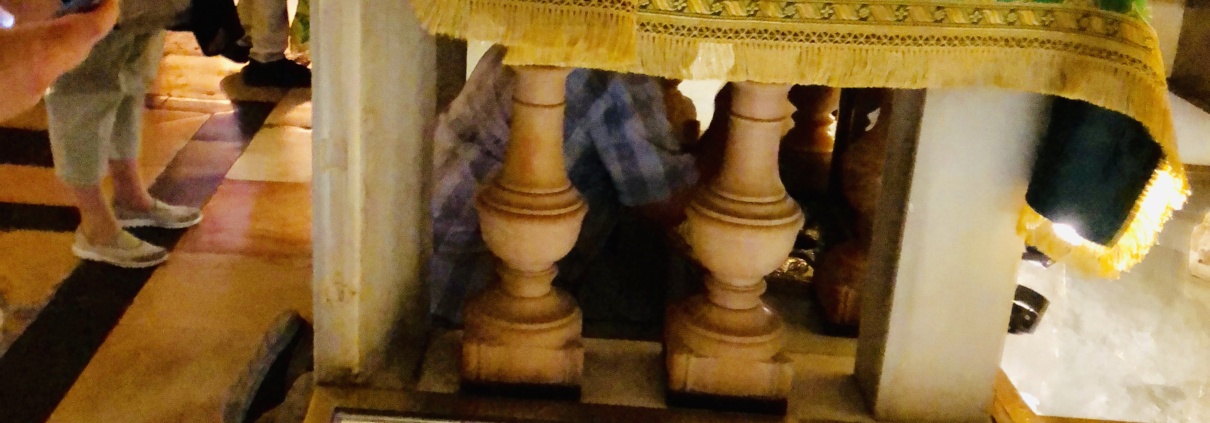The Cross and the Eucharist
By Msgr. Gerald Twaddell.
Day in and day out, from morning to evening, hundreds of people — some true pilgrims, others merely tourists — make their way to the Church of the Holy Sepulchre in Jerusalem’s Old City. They climb the steep stairway not far to the right inside the main door to reach Calvary. The line slowly moves past the altar commemorating the place where Jesus was stripped of his garments, then where he was nailed to the cross. At the altar in the Chapel of the Crucifixion they kneel, one by one, to reach under the altar to put a hand down into the shaft where the Cross once stood. Some are so moved that they remain there as time passes, delaying the opportunity for the next person who will follow their example; others, conscious of the crowd waiting behind them, move on more quickly. What is the attraction of this ritual?
Surely whatever else might have brought these people to the Holy City, at least one reason for them to be there is to connect with something very ancient, very sacred. How many other sites in the world offer such a tactile, intimate encounter as the one that can be experienced in this holiest of places? There are so many sites in the Holy Land where one is allowed to touch, with little or no barrier, a place where Jesus stood, or sat or knelt. How many more recent historical sites offer a visitor that? But here, the gentle, awed caress of the devout pilgrims is unlikely to wear down these millennial stones too rapidly. The monks who guard the sites watch mainly to ensure that decorum is preserved.
So the history of the place, its accessibility, its profound significance for the story of the human race, its salvation, all draw people. And yet, what they find is but a memory of a past event. All that remains are the relics of a distant past. The reality is not there, however sacred the artifacts may be. The Cross of Christ is gone, splintered among myriad relics spread across the world. What remains is what it once touched. And that, in the end, is all we can touch here at Calvary. So, however moving that experience, there could be something more.
What if we could have been there on the day of the Crucifixion? Perhaps we might have been part of the crowd on the road into Jerusalem just a few days earlier chanting, “Hosanna to the Son of David.” But that crowd didn’t follow him to Calvary. Do we think we would have been any different? Jesus knew how people, even his closest followers, would flee, leaving him to stand trial for sedition against the Roman Empire without a single witness on his side. On the very eve of all that, he warned them that all would be scandalized: “Then Jesus said to them, ‘You will all become deserters because of me this night; for it is written, I will strike the shepherd, and the sheep of the flock will be scattered.’ ” (Mt 26:31) Maybe we would not have wanted to be there either, but if we had had the courage of John, of his Mother Mary, of his aunt and the other Mary we might have stood there with them at the foot of the Cross, risking not only the ridicule of the officials, but the danger of being accused of a crime ourselves.
What is more, had we known then what we know now about the Resurrection to come, we would not have been scandalized at all. We would have understood the ghastly scene as the price Jesus was willing to pay to redeem the whole human race. We would have known the truth of what St. Paul would write later: “that Christ died for our sins in accordance with the scriptures, and that he was buried, and that he was raised on the third day in accordance with the scriptures” (1 Cor 15:3-4). Such thoughts, though, are sad “what ifs” aren’t they? None of that was possible, not least of all because we have come into the world twenty centuries too late.
If the sword of Mary’s sorrow beside her dying Son could prick our hard hearts though, would we not really want to be there? Not just at the place where it happened once so long ago in history, but right there, right then as it all unfolds, hearing Jesus pronounce his triumphant judgment on the sins of the world: “It is finished.” Yes, there could never be a better place, a better time to be than at that central moment in salvation history.
And the awe-inspiring truth is that we actually can do just that: be at the Cross, as Jesus redeems the world. How you ask? Pope Pius XII, in his encyclical “Mediator Dei” (§3) explains: “the Church prolongs the priestly mission of Jesus Christ mainly by means of the sacred liturgy. She does this in the first place at the altar, where constantly the sacrifice of the Cross is represented and, with a single difference in the manner of its offering, renewed.”
Our celebration of the Eucharistic Liturgy draws us into the depths of the Mystery of Christ, the mystery of salvation. When we enter the liturgy we step out of time and into the reality of eternity. Time fades away, leaving us standing about the Altar of the Lamb where we share in the Heavenly Liturgy. As the Second Council of the Vatican taught: “In the earthly liturgy we take part in a foretaste of that heavenly liturgy which is celebrated in the holy city of Jerusalem toward which we journey as pilgrims, where Christ is sitting at the right hand of God.” (“Sacrosanctum Concilium,” §8)
Our liturgy and the liturgy of heaven are made one: we are made present at the eternal offering of the sacrifice of Calvary to the heavenly Father and joined with all the saints at the banquet of heaven. As the Catechism of the Catholic Church puts it: “By the Eucharistic celebration we already unite ourselves with the heavenly liturgy and anticipate eternal life, when God will be all in all.” (CCC 1326) This is as close to heaven as we can get and still be in this world. Just think: we are really present in the heavenly liturgy. As the Catechism teaches, reaching back to the words of the Council of Trent (Cf. DS 1743): “The sacrifice of Christ and the sacrifice of the Eucharist are one single sacrifice: the victim is one and the same: the same now offered through the ministry of priests, who then offered himself on the cross; only the manner of offering is different. In this divine sacrifice which is celebrated in the Mass, the same Christ who offered himself once in a bloody manner on the altar of the Cross is contained and is offered in an unbloody manner.” (CCC 1367)
The sacrifice of Christ on Calvary is what the Eucharist simply is. Jesus is really present in all his reality, dying to redeem us, rising to bring us eternal life. To participate in the celebration of Mass transports us really and truly to the altar of the Cross. To understand this truth should thrill us to our depths. Heaven joined with earth, and we can be there! How could we ever imagine a substitute for that? Could an hour in nature compare? Could sitting at home reading the newspaper, sipping coffee, have anything near the value of this encounter with Christ Crucified? Shouldn’t we all burst into a joyful song of Christ’s victory (and ours): “Lift high the Cross, the love of Christ proclaim till all the world adore His sacred name” ? (“Lift High the Cross” © 1978, Hope Publishing Co.)
Msgr. Gerald E. Twaddell, KHS, is prior of the Covington section of the Equestrian Order of the Holy Sepulchre of Jerusalem; chaplain of the Monastery of the Sacred Passion, Erlanger; professor of philosophy and rector of Mary, Seat of Wisdom Chapel at Thomas More University.



